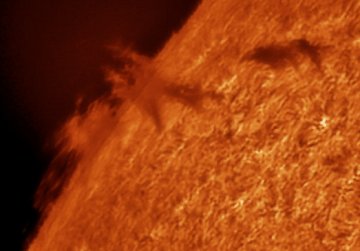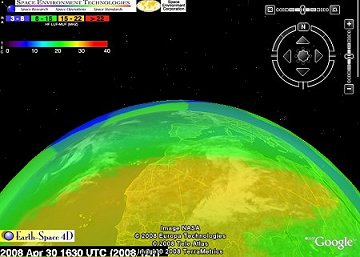| MOTHER'S DAY: Give your mom a truly heavenly gift on May 11th--a subscription to Space Weather PHONE! | | | FLYBY ALERT: The International Space Station (ISS) is just beginning a 4-week series of bright flybys over Europe and North America. In early May, the ISS joins Jupiter and the stars of the Summer Triangle in a glittering pre-dawn sky. Later in the month, flybys shift to evening hours and the ISS will cross paths with Saturn, the Moon and Mars. US and Canadian readers, find out when to look using our new Simple Flybys tool. A worldwide version is coming soon; stay tuned. SOLAR FILAMENT: Today, a dark magnetic filament is snaking over the sun's western limb, producing a beautiful 3D scene for amateur astronomers to photograph. It's "rather wonderful," says Pete Lawrence, who sends this snapshot from his backyard observatory in Selsey, UK: 
Filaments are clouds of hydrogen held above the surface of the sun by magnetic fields. Backlit by the inferno below, they appear dark and cool, but that is an illusion. Like all things solar, filamentary clouds are bright and red-hot. We see this most clearly when a filament juts into the black of space beyond the sun's edge, as this one is doing in the left half of the photo. In fact, this filament is about to go all the way over the edge, reclassifying itself from filament to prominence. If you have a solar telescope, train it on the western limb of the sun and watch the metamorphasis. more images: from James Kevin Ty of Manila, the Philippines; from E. Signorelli and J. Stetson of South Portland, Maine; from Peter Paice of Belfast, Northern Ireland; from Malcolm Park of London, England, UK; from Maxim Usatov of Prague, the Czech Republic; 4D IONOSPHERE: The ionosphere is our planet's "final frontier." A realm of dancing auroras, radio-bending plasma bubbles and dangerous ultraviolet rays, it is the last wisp of Earth's atmosphere that astronauts leave behind when they enter space. And now it is on your home computer! (continued below) 
Above: A screenshot of the 4D ionosphere
Yesterday, NASA-supported researchers at the Space Weather Workshop in Boulder, Colorado, unveiled a "4D" computer model for the general public. Download a few files and presto--you're flying through the ionosphere. The model shows the ionosphere as it is right now; it's a real-time display based on current solar activity and atmospheric conditions. This new tool can help ham radio operators plan their next DX transmissions, help pilots avoid polar radio blackouts, and help researchers see the effects of solar flares on Earth's atmosphere--and it's fun, too. Get the full story from Science@NASA.
April 2008 Aurora Gallery
[Aurora Alerts] [Night-sky Cameras] | 
